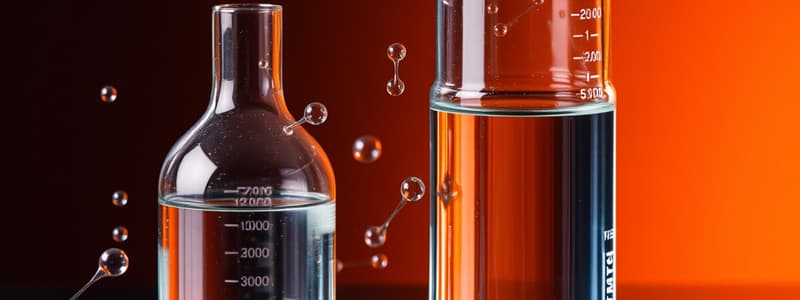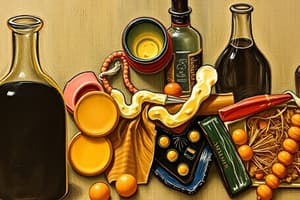Podcast
Questions and Answers
What type of mixture is a solution classified as?
What type of mixture is a solution classified as?
- Heterogeneous mixture
- Suspension
- Colloid
- Homogeneous mixture (correct)
Which statement correctly describes the particles in a colloid?
Which statement correctly describes the particles in a colloid?
- Individual atoms or ions
- Soluble ions only
- Small, uniform molecules
- Macromolecules or aggregations of small molecules (correct)
Which factor does not affect the solubility of a solute?
Which factor does not affect the solubility of a solute?
- Color of the solute (correct)
- Temperature of the solvent
- Pressure applied to the solute
- Nature of the solute and solvent
What does the term 'like dissolves in like' imply?
What does the term 'like dissolves in like' imply?
When a solution forms, what happens to the attractions between solute and solvent?
When a solution forms, what happens to the attractions between solute and solvent?
Based on the data provided, what mass percentage of the solution is made up of macromolecules?
Based on the data provided, what mass percentage of the solution is made up of macromolecules?
What is typically the most abundant component in a solution?
What is typically the most abundant component in a solution?
What is the nature of a colloid compared to a solution?
What is the nature of a colloid compared to a solution?
Which type of forces allow NaCl to dissolve in polar solvents?
Which type of forces allow NaCl to dissolve in polar solvents?
What happens during the first step of the dissolution process?
What happens during the first step of the dissolution process?
What type of forces orient water molecules around an ion?
What type of forces orient water molecules around an ion?
Which statement is true regarding the hydration of ions?
Which statement is true regarding the hydration of ions?
What is the overall enthalpy change when a solute and solvent mix?
What is the overall enthalpy change when a solute and solvent mix?
Which statement about alcohols is true?
Which statement about alcohols is true?
Predict the solubility of sodium chloride in 1-propanol compared to methanol.
Predict the solubility of sodium chloride in 1-propanol compared to methanol.
Which compound is likely to dissolve better in 1-propanol compared to methanol?
Which compound is likely to dissolve better in 1-propanol compared to methanol?
How do alcohols interact with water?
How do alcohols interact with water?
Which of the following correctly describes the role of ethylene glycol in a solution?
Which of the following correctly describes the role of ethylene glycol in a solution?
Why are hydrogen bonds in water more effective than dipole-induced dipole forces with hexane?
Why are hydrogen bonds in water more effective than dipole-induced dipole forces with hexane?
Which alcohol has the highest solubility in water?
Which alcohol has the highest solubility in water?
Which statement is correct about the endothermic nature of the dissolution process?
Which statement is correct about the endothermic nature of the dissolution process?
What is the primary interaction between hexane and the hydrocarbon portion of alcohols?
What is the primary interaction between hexane and the hydrocarbon portion of alcohols?
Which solvent would ethylene glycol be least soluble in?
Which solvent would ethylene glycol be least soluble in?
What general principle is described in the phrase 'like dissolves like'?
What general principle is described in the phrase 'like dissolves like'?
What is the molality of H2O2 in the solution?
What is the molality of H2O2 in the solution?
How many moles of H2O are present in the solution?
How many moles of H2O are present in the solution?
What is the mole fraction of H2O2 in the solution?
What is the mole fraction of H2O2 in the solution?
What is the volume of the solution in mL given the mass and density?
What is the volume of the solution in mL given the mass and density?
What is the molarity of H2O2 in the solution?
What is the molarity of H2O2 in the solution?
What is the primary reason for the higher solubility of most solids at elevated temperatures?
What is the primary reason for the higher solubility of most solids at elevated temperatures?
Which statement best describes a supersaturated solution?
Which statement best describes a supersaturated solution?
Why does the solubility of gases decrease as temperature increases?
Why does the solubility of gases decrease as temperature increases?
What happens to the solubility of gases when pressure is increased?
What happens to the solubility of gases when pressure is increased?
What is the relationship between the partial pressure of a gas and its solubility in a solution?
What is the relationship between the partial pressure of a gas and its solubility in a solution?
Which of the following describes a saturated solution?
Which of the following describes a saturated solution?
For NaCl, what is true about its enthalpy of solution compared to its entropy change during dissolution?
For NaCl, what is true about its enthalpy of solution compared to its entropy change during dissolution?
What characterizes an unsaturated solution?
What characterizes an unsaturated solution?
Flashcards are hidden until you start studying
Study Notes
Solutions and Colloids
- Solutions are homogeneous mixtures with a single phase, while colloids are heterogeneous mixtures with distinct phases.
- Solutions contain individual atoms, ions, or small molecules, whereas colloids consist of macromolecules or aggregations of small molecules.
Composition of Cellular Solutions
- Water makes up approximately 70% of cell mass.
- Other solutes in cells include ions (1%), sugars (3%), amino acids (0.4%), lipids (2%), and macromolecules (23%).
- Solubility is influenced by the interaction between solute and solvent, summarized by the expression "like dissolves in like."
Intermolecular Forces
- Various types of intermolecular forces include ion-dipole (40-600 kJ/mol), hydrogen bonding (10-40 kJ/mol), and dispersion forces (0.05-40 kJ/mol).
- Solvent-solvent and solute-solute attractions are replaced by solute-solvent attractions during solution formation, requiring similar intermolecular forces.
Alcohols and Solubility
- Alcohols feature a polar –OH group, which allows them to interact with water and hydrocarbons through different intermolecular forces.
- Solubility of alcohols in water decreases with increased hydrocarbon chain length, while solubility in hexane increases.
Solvation Process
- Solvation, or hydration in water, involves surrounding solute particles with solvent molecules.
- Hydration of ions is exothermic, as it involves strong ion-dipole attractions.
Entropy and Solutions
- Entropy (S) measures a system's energy dispersion and freedom of motion, with gases displaying the highest entropy.
- Solutions generally have higher entropy compared to pure solutes and solvents; entropy increases favor the dissolution process.
Types of Solutions
- A saturated solution contains the maximum dissolved solute possible at a given temperature, while unsaturated solutions can accommodate more solute.
- Supersaturated solutions are unstable and contain excess solute, which crystallizes upon disturbance.
Effect of Temperature and Pressure on Solubility
- Solubility of solids typically increases with temperature; gas solubility decreases as temperature rises.
- Gas solubility increases with pressure, governed by the equation S_gas = k_H × P_gas (Henry's Law).
Example Calculations
- Given a solution with 30.0 g H2O2 and 70.0 g H2O, molality can be calculated, resulting in 12.6 m H2O2.
- Conversions from mass percentage to mole fraction and from mass percentage/density to molarity can be performed to determine the concentration of solutions.
Studying That Suits You
Use AI to generate personalized quizzes and flashcards to suit your learning preferences.




